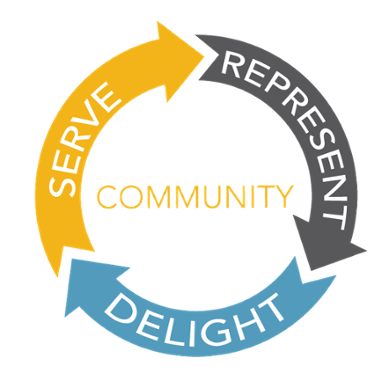These days, nearly every local government organization has a website, but a recent survey revealed only 34% of local government staff believe their websites are highly effective. Why is that? Through the process of identifying the technology to use, enlisting staff to make basic edits and changes, and handling the day-to-day management of the site, it can be easy to lose focus on why your organization has a website to begin with. It’s a basic, but critical question: What is the purpose of your website?
Through insights gained by helping hundreds of municipalities develop and maintain their websites, Granicus has identified three fundamental purposes: to Serve, Represent and Delight the community. Let’s dig into what this means.

1. Serve the Community
The notion of service is fundamental to the mission of local governments, and your website is the digital portal to accomplishing this mission. In simple terms, the website should SERVE citizens by providing access to key services, as well as allowing them to conduct business online. The organization also has a responsibility to share information about what’s happening in the community and to promote governmental transparency through sharing information and data.
Take the case of the City of San Luis Obispo, California (SLO):

Front and center on the homepage is a large search bar with the helpful suggestion of “How can we help?” providing citizens with an easy way to find the information that they want without trying to locate it on a menu or sub-menu. There are also prominent buttons to “Report an Issue”, “Sign up for e-Notifications” and “Online Payments”. Through understanding what citizens are seeking when they visit the website, SLO was able to ensure that these most-used requests were easy to find.
For citizens that want to access additional city services, they can click on the Services menu item where an expanded menu provides a list of key departments and the most requested services. The expanded menu allows citizens to quickly find the information they seek in the fewest number of keystrokes.

Another example of serving the community comes from the City of Ankeny, Iowa which highlights the importance of considering the needs of Businesses and Visitors, too. In a prominent location on their homepage, Ankeny asks the question “What are you looking for?”. Quick search button drop-downs address the needs of Residents, Businesses and Visitors.

In addition to providing the ability to conduct business with your organization online, Serving the community also means demonstrating proactive compliance with regulations for information and accessibility. While you can check out a full list of transparency recommendations from Ballotpedia, you can start by making it easy for residents to find out what’s going on with your elected bodies. For example, prominently display City Council agendas and minutes on the homepage.
To summarize, here are the key themes that are critical to SERVING your community:

2. Represent the Community
The second purpose of a local government website is to represent or brand the community, its leaders and organization. Ask yourself: Does your digital front-door reflect your community’s values and brand? Would someone who had never visited your area get a sense for what your community is all about by visiting your website? If you’re not sure, these questions are a great starting point to uncover the elements that should be showcased in order to accurately represent your community:
- What makes your community unique?
- Why would someone want to move into your community?
- Why would someone want to build a business in your community?
- What are you doing to attract visitors and what resources are available to make their visit memorable?
- Do any of your key departments – police, fire, library, economic development – want to build a separate brand?
- What are you doing to build civic pride in your area?
Here are examples of how some of our customers are using their websites to represent their communities.
The City of Palm Springs, California is known for its hot springs, stylish hotels, golf courses and spas. It is also notable for its many fine examples of midcentury-modern architecture, and the core shopping district features vintage boutiques, hip interior design shops and buzzy restaurants. Palm Springs wants their website to represent their unique retro brand.

Monterey County’s website showcases Central California’s Monterey Peninsula as a tourist destination. Their homepage displays a rotating slide show with stunning professionally-taken photos that highlight an activity in each of the local cities of Pebble Beach, Monterey, Monterey Bay, Castroville, Carmel, Salinas Valley, Soledad and Salinas. The navigation buttons across the bottom of the page are transparent to allow for a larger full-page image which makes the page more inviting too.

Tourism is also important to the City of Bend, Oregon and they balance serving their community with representing the natural beauty and numerous outdoor activities in a series of beautiful postcard-like pictures on their homepage.

While representing the community is largely about showcasing the area, it’s also an opportunity to brand your leadership. In Provo, Utah, their mayor uses his page on the city’s website to share and communicate his priorities and initiatives. He also uses the page to display his unique brand and personality by providing links to his blog, Instagram feed, Facebook page and Twitter account. Providing a channel for city officials to represent themselves in a positive light makes government more approachable and human.

To summarize, here are the key themes to consider when REPRESENTINGyour community:

3. Delight the Community
The final purpose of your website is to DELIGHT your community. Let’s face it: Paying parking tickets, applying for permits or finding out about business license requirements can hardly be described as “delightful” experiences. But, when completing these tasks is simple and easy, seeds of delight are planted. Your website offers a unique opportunity to change opinions for the positive and make the experience of interacting with government pleasant and enjoyable. Three important concepts come into play when creating websites that are meant to delight:
- Usability – making interfaces and navigation that almost anyone can use without much thought or training
- Content strategy – providing clear, succinct content that is written from the residents’ perspective and avoids “government speak”
- Data – measuring actions and analyzing data to customize the look and feel of websites; and to inform ongoing digital strategy and future updates
On the City of Reno, Nevada website, users are immediately greeted with familiar, colorful images supplied by local photographers. Once there, they are directed to the most frequently requested content. Buttons like “Get Involved”, “Report an Issue”, “Online Services” and “View Webcams” take users directly to the content they want to see, without requiring them to know what department offers those services.

For the City of Newport Beach, California, delighting the community means thinking like a user and creating navigation to ensure that access to content is simple and logical to find. By utilizing a “I am a” guide in the main navigation menu, they are able to target content to a wide range of audiences with a simple click. Taking the lead from social media, Newport Beach also has a Trending category that gives residents access to information that others are also requesting. The end result is a pleasing, delightful experience to users who are not familiar with the inner workings of government.

Making sure your website looks great on mobile devices is also an important part of delighting your community. More than 50% of your website traffic comes from mobile devices and Pew Research recently conducted a survey that discovered 1 in 5 Americans can ONLY access the Internet from mobile devices. In the “think mobile first” mode, West Hollywood is able to leverage their visionCMS™ website to present an entirely different interface to mobile users, without needing a separate mobile site or application.

To summarize, here are the key themes to consider for developing websites that DELIGHT your community:

With this framework in mind, is your website fulfilling its purpose? Our hope is that seeing what your peers have implemented will provide a starting point for answering this critical question. If you’re not sure where to start, let us know and we would be happy to help conduct a quick assessment of your site.






